Digital Poster
MR Fingerprinting & Synthetic MRI Methods
ISMRM & ISMRT Annual Meeting & Exhibition • 03-08 June 2023 • Toronto, ON, Canada

| Computer # | |||
|---|---|---|---|
2175.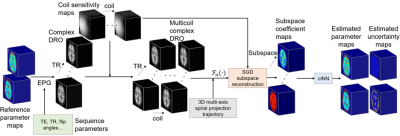 |
1 | A New Framework for 3D MR Fingerprinting with Efficient Subspace Reconstruction and Joint Posterior Distribution Estimation
Jiaren Zou1,2, Yuchi Liu3, Jesse Hamilton2,3, Yun Jiang2,3, Nicole Seiberlich2,3, and Yue Cao1,2,3
1Department of Radiation Oncology, University of Michigan, Ann Arbor, MI, United States, 2Department of Biomedical Engineering, University of Michigan, Ann Arbor, MI, United States, 3Department of Radiology, University of Michigan, Ann Arbor, MI, United States Keywords: MR Fingerprinting/Synthetic MR, MR Fingerprinting Iterative image reconstruction of highly undersampled high-resolution 3D MR fingerprinting (MRF) is time-consuming and has high memory requirements. In this work, we propose to use stochastic gradient descent to accelerate the reconstruction and reduce the memory footprint. In addition, a conditional invertible neural network is used as a fast and flexible tool for estimating the posterior distribution of tissue properties from MRF. In a simulation study, we achieved an 11-fold and 45.5GB reduction in reconstruction time and memory requirement, respectively, compared with a conventional iterative method. Uncertainty maps of tissue properties derived from the estimated posterior distributions correlate well with reconstruction errors. |
|
2176.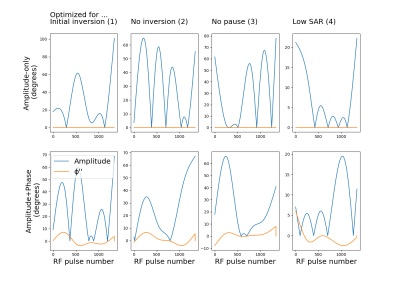 |
2 | Multi-parametric quantitative MRI without inversion pulses by optimized RF phase modulation
Miha Fuderer1, Hongyan Liu1, Oscar van der Heide1, Cornelis A.T. van den Berg1, and Alessandro Sbrizzi1
1Division Imaging and Oncology, University Medical Center Utrecht, Utrecht, Netherlands Keywords: MR Fingerprinting/Synthetic MR, Relaxometry We applied optimized phase modulation to the RF sequence in MR-STAT. We observe that applying optimized phase is beneficial towards the accuracy of T1 and T2 maps, particularly under constrained conditions. In particular, when comparing sequences with and without an initial inversion pulse we observe that the difference vanishes when applying optimized RF phase modulation. Thus optimized phase modulation allows to omit the initial inversion pulse. We hypothesize that the same holds for other multi-parametric qMRI techniques such as MRF. |
|
2177.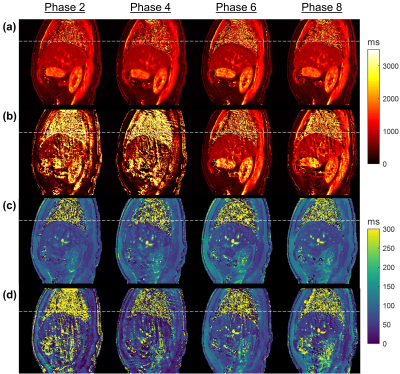 |
3 | Enhancing the precision of multi-phase parametric maps in 4D-MRF by optimization of local T1 and T2 sensitivities
Yat Lam Wong1, Tian Li1, Chenyang Liu1, Victor Ho Fun Lee2, Lai Yin Andy Cheung3, Peng Cao4, Edward Sai Kam Hui5, and Jing Cai1
1Department of Health Technology and Informatics, The Hong Kong Polytechnic University, Hong Kong, Hong Kong, 2Department of Clinical Oncology, The University of Hong Kong, Hong Kong, Hong Kong, 3Department of Clinical Oncology, Queen Mary Hospital, Hong Kong, Hong Kong, 4Department of Diagnostic Radiology, The University of Hong Kong, Hong Kong, Hong Kong, 5The Chinese University of Hong Kong, Hong Kong, Hong Kong Keywords: MR Fingerprinting/Synthetic MR, MR Fingerprinting Time-resolved magnetic resonance fingerprinting (MRF), or 4D-MRF, has demonstrated its feasibility in motion management in radiotherapy (RT). However, the prohibitive long acquisition time is one of challenges of the clinical implementation of 4D-MRF. The shortening of acquisition time may compromise the accuracies of the predicted tissues’ properties. Here, we propose a novel technique to enhance the accuracies of 4D-MRF with shortened acquisition by optimizing T1 and T2 sensitivities through inter-phase data sharing. |
|
2178.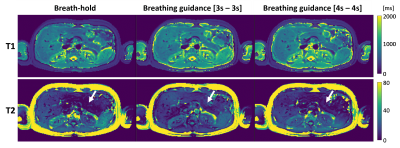 |
4 | Abdominal MR Fingerprinting with In-bore Breathing Guidance
Yoo Jin Lee1, Peter Koken1, Kristina Sonnabend2,3,4, Grischa Bratke3,4, Annerieke Heuvelink-Marck5, and Mariya Doneva1
1Philips Research, Hamburg, Germany, 2Philips GmbH Market DACH, Hamburg, Germany, 3Faculty of Medicine, University of Cologne, Cologne, Germany, 4Institute for Diagnostic and Interventional Radiology, University Hospital Cologne, Cologne, Germany, 5Philips Research, Eindhoven, Netherlands Keywords: MR Fingerprinting/Synthetic MR, Body, Respiratory motion MR fingerprinting (MRF) in the abdomen is challenging due to respiratory motion. In this study, as an alternative to a series of extended breath-holds which could be challenging especially for patients, visual and auditive in-bore breathing guidance was used during the MRF scans for better patient comfort. MRF sequences were designed based on predefined breathing patterns such that data are acquired only during exhale holds. The corresponding MRF dictionaries were calculated beforehand to enable real-time matching of quantitative maps. We demonstrate that MRF scans with guided breathing provide comparable abdominal T1 and T2 maps as those with breath-holds. |
|
2179.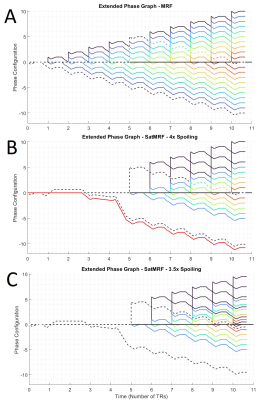 |
5 | Incorporating fat and spatial saturation in MR Fingerprinting
Christopher George Trimble1, Kaia I. Sørland1, Tone F. Bathen1,2, Mattijs Elschot1,2, and Martijn A. Cloos3
1Department of Circulation and Medical Imaging, Norwegian University of Science and Technology (NTNU), Trondheim, Norway, 2Department of Radiology and Nuclear Medicine, St Olavs Hospital, Trondheim, Norway, 3Centre for Advanced Imaging, University of Queensland, Brisbane, Australia Keywords: MR Fingerprinting/Synthetic MR, Prostate Magnetic Resonance Fingerprinting (MRF) enables fast quantitative MR imaging, and represents an opportunity to improve upon the current standard of multi-parametric MRI (mp-MRI). In this work we demonstrate how the MRF pulse sequence can be adapted to include different saturation techniques, whilst retaining accurate T1 and T2 quantification. Extended Phase Graphs (EPGs) of the sequence illustrate the effective spoiling of chemical elements, such as fat, and spatial saturation. Phantom imaging shows that T1 quantification is not significantly affected and T2 quantification remains accurate up to 100ms. As an example, the framework is tested in-vivo in the context of prostate imaging. |
|
2180.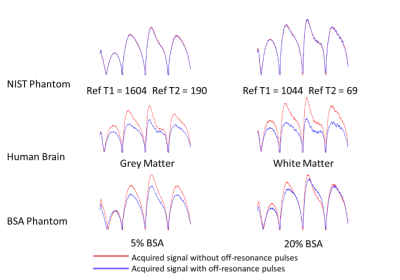 |
6 | Magnetisation Transfer effects on T1 and T2 values in MR Fingerprinting
Simran Kukran1,2, Iulius Dragonu3, Ben Statton1,4, Jack Allen5, Pete Lally1,6, Rebecca Quest1,7, Neal Bangerter1, Dow-Mu Koh2, Matthew Orton2, and Matthew Grech-Sollars8
1Imperial College London, London, United Kingdom, 2Institute of Cancer Research, London, United Kingdom, 3Siemens Healthcare Ltd, Frimley, United Kingdom, 4London Institute of Medical Sciences, Medical Research Council, London, United Kingdom, 5Independent Researcher, Norwich, United Kingdom, 6UK Dementia Research Institute Centre for Care Research and Technology, London, United Kingdom, 7Imperial College Healthcare NHS Trust, London, United Kingdom, 8University College London, London, United Kingdom Keywords: MR Fingerprinting/Synthetic MR, Magnetization transfer A fingerprinting sequence was developed with and without off resonance pulses before every TR to investigate MT effects on T1 and T2 values. Off-resonance pulses suppress MT effects by saturating signal from free protons that exchange with bound protons. Observed T2 values increased with off resonance pulses as expected. Observed T1 values decreased, this was an opposite effect to what was observed previously with a different pulse sequence. |
|
2181. |
7 | A steady-state MRF sequence optimization framework for 3D simultaneous water T1 and fat fraction mapping
Constantin Slioussarenko1, Pierre-Yves Baudin1, and Benjamin Marty1
1NMR Laboratory, Neuromuscular Investigation Center, Institute of Myology, Paris, France Keywords: MR Fingerprinting/Synthetic MR, MR Fingerprinting We introduce an optimization framework using the longitudinal steady-state equilibrium for FLASH MRF sequences, and taking into account signal noise by using a Monte Carlo method. We use this framework to optimize echo times, flip angles, timings and recovery time for T1H2O and FF mapping while shortening our original MRF T1-FF sequence. The resulting Fast MRF T1-FF sequence yields comparable estimation results to the original sequence with an almost twice reduced acquisition time. |
|
2182.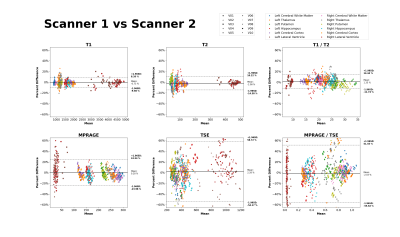 |
8 | Quantifying 3D-MRF Reproducibility Across Subjects, Sessions, and Scanners Automatically Using MNI Atlases
Andrew Dupuis1, Yong Chen1, Michael Hansen2, Kelvin Chow3, Dan Ma1, Mark Griswold1, and Rasim Boyacioglu1
1Biomedical Engineering, Case Western Reserve University, Cleveland, OH, United States, 2Microsoft Research, Redmond, WA, United States, 3Siemens Medical Solutions USA, Inc., Chicago, IL, United States Keywords: MR Fingerprinting/Synthetic MR, Quantitative Imaging, Reproducibility, MNI, Automated, Gadgetron, FIRE We evaluate the reproducibility of 3D-MRF versus clinical-standard MPRAGE and TSE acquisitions for ten subjects across three acquisition sets on two scanner via a fully-automated registration and regional analysis framework. T1 and T2 quantitative maps from 3D-MRF were found to be highly reproducible (T1+/-4.6%, T2+/-6.3%) across scanners and sessions, with no significant difference between repeating a scan immediately on the same scanner, repeating a scan after repositioning the subject and reshimming, and repeating a scan on a different scanner entirely. The same is not true for MPRAGE (+/-12.4%) or TSE (+/-28.8%) acquisitions. |
|
2183.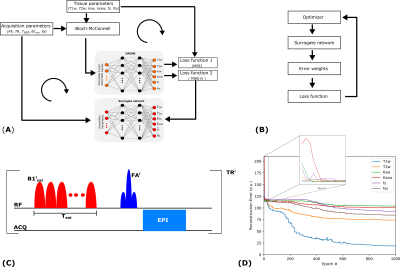 |
9 | Deep learning optimization of CEST MR Fingerprinting (CEST-MRF) for Quantitative Human Brain Mapping
Ouri Cohen1 and Ricardo Otazo1
1Medical Physics, Memorial Sloan Kettering, New York, NY, United States Keywords: MR Fingerprinting/Synthetic MR, CEST & MT CEST MR fingerprinting (CEST-MRF) enables fast quantitative relaxation and exchange mapping. The CEST-MRF signal depends on multiple acquisition and tissue parameters which makes optimization of the acquisition schedule challenging. The goal of this work is to develop a deep learning approach that uses a quantification network and a surrogate network to optimize the acquisition schedule for in vivo scans. Numerical simulations are used to characterize the optimized schedule and the benefits of optimization are demonstrated in vivo in a healthy subject. The optimized schedule can reduce scan time by 12% and provide better image quality than a randomly generated schedule. |
|
2184.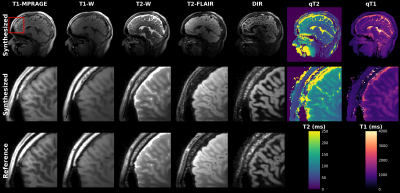 |
10 | Five clinical contrasts from 1 minute whole brain MRF with B0 correction
Sophie Schauman1,2, Siddharth Iyer3,4, Xiaozhi Cao1,2, Quan Chen1,2, Mahmut Yurt1,2, Natthanan Ruengchaijatuporn5, Congyu Liao1,2, Greg Zaharchuk1, and Kawin Setsompop1,2
1Department of Radiology, Stanford University, Stanford, CA, United States, 2Department of Electrical Engineering, Stanford University, Stanford, CA, United States, 3Athinoula A. Martinos Center for Biomedical Imaging, Massachusetts General Hospital, Charlestown, MA, United States, 4Department of Electrical Engineering and Computer Science, MIT, Cambridge, MA, United States, 5Center of Excellence in Computational Molecular Biology, Chulalongkorn University, Bangkok, Thailand Keywords: MR Fingerprinting/Synthetic MR, MR Fingerprinting Clinical contrasts can be generated from a 1 min 1 mm isotropic whole brain MRF scan and B0 correction improves it further. We tested this method in healthy volunteers as well as clinical populations. |
|
2185. |
11 | Neural Network-Based Removal of Colored Noise in MR Fingerprinting
Jakob Meineke1, Christian Wülker1, Jean Tkach2, Usha Nagaraj2, Mariya Doneva1, and Tim Nielsen1
1Philips Reseach, Hamburg, Germany, 2Department of Radiology, Cincinnati Children's Hospital Medical Center, Cincinnati, OH, United States Keywords: MR Fingerprinting/Synthetic MR, MR Fingerprinting A neural network for the estimation and removal of colored noise in non-Cartesian MRI is trained and subsequently applied for denoising coefficient images in MR Fingerprinting. It is shown that the neural network does not introduce bias in the quantitative parameter maps and improves their precision. Invivo T1- and T2-maps are demonstrated to be visually improved. |
|
2186.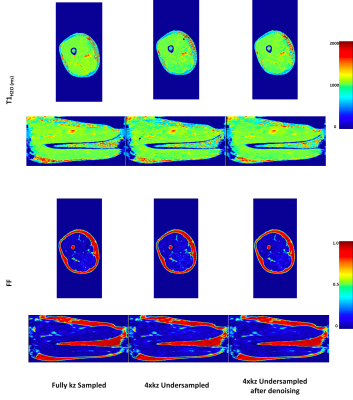 |
12 | Iterative denoising of undersampled 3D MRF with exact line search and spatial regularization
Constantin Slioussarenko1 and Benjamin Marty1
1NMR Laboratory, Neuromuscular Investigation Center, Institute of Myology, Paris, France Keywords: MR Fingerprinting/Synthetic MR, Sparse & Low-Rank Models We propose an iterative algorithm to remove remaining artefacts of Magnetic Resonance Fingerprinting maps, using projected gradient descent with exact line search and spatial regularization. We use this framework to denoise 3D MRF T1-FF acquisitions undersampled in the partition direction and show that this allows to reduce undersampling artefacts for the T1H2O and FF maps after a few iterations. |
|
2187.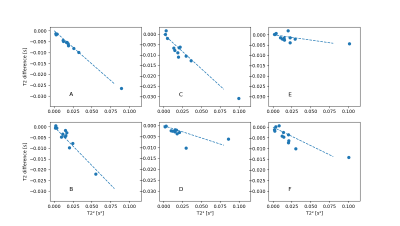 |
13 | The influence of diffusion in fast multi-parametric relaxometry
Miha Fuderer1, Oscar van der Heide1, C.A.T. van den Berg1, and Alessandro Sbrizzi1
1Division Imaging and Oncology, University Medical Center Utrecht, Utrecht, Netherlands Keywords: MR Fingerprinting/Synthetic MR, Relaxometry In MRF, it has been established – but often ignored – that the presence of diffusion causes bias in the estimated T2. We measure this effect in MR-STAT. Thereby we confirm the theoretical model that the bias is proportional to the square of T2. We also find that the bias level strongly depends on the RF sequence used. This opens the prospect of optimizing sequences on minimal diffusion-induced bias in T2. |
|
2188.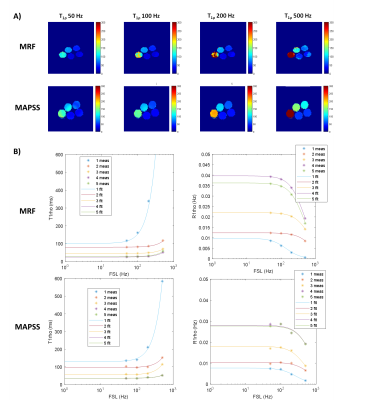 |
14 | T1ρ Dispersion Characterization by Magnetic Resonance Fingerprinting
Brendan Eck1,2, Jeehun Kim2,3, Mingrui Yang2, and Xiaojuan Li2
1Imaging Institute, Cleveland Clinic, Cleveland, OH, United States, 2Department of Biomedical Engineering, Program of Advanced Musculoskeletal Imaging (PAMI), Cleveland Clinic, Cleveland, OH, United States, 3Department of Electrical, Computer, and Systems Engineering, Case Western Reserve University, Cleveland, OH, United States Keywords: MR Fingerprinting/Synthetic MR, Quantitative Imaging, T1rho Dispersion T1ρ dispersion is a potential biomarker that can characterize chemical exchange or diffusive exchange, complementary to other MR relaxometry parameters (e.g. T1, T2). However, T1ρ dispersion conventionally involves quantification of T1ρ at multiple spin-lock frequencies, which can require prohibitively long scan times and high radiofrequency pulse energy deposition. MR Fingerprinting (MRF) has been reported for quantification of T1ρ at a single spin-lock frequency. We propose a framework to enable T1ρ dispersion MRF data acquisition and reconstruction. We report initial simulation and real-world phantom results that demonstrate the feasibility of this MRF-based T1ρ dispersion characterization method. |
|
2189.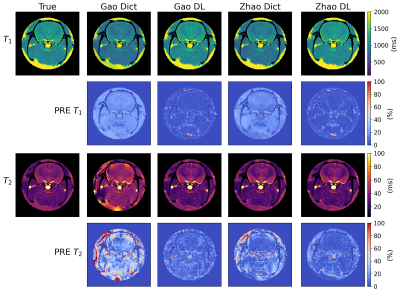 |
15 | Fast Deep Learning models for Magnetic Resonance Fingerprinting
Raffaella Fiamma Cabini1,2, Davide Cicolari2,3, Leonardo Barzaghi1,4, Paolo Arosio5,6, Stefano Carrazza5,6, Silvia Figini2,7, Marta Filibian2,8, Marco Peviani9, Anna Pichiecchio4,10, and Alessandro Lascialfari2,3
1Mathematics, University of Pavia, Pavia, Italy, 2INFN, Istituto Nazionale di Fisica Nucleare, Pavia, Italy, 3Physics, University of Pavia, Pavia, Italy, 4Advanced Imaging and Radiomics, Department of Neuroradiology, IRCCS Mondino Foundation, Pavia, Italy, 5Physics, University of Milano, Milano, Italy, 6INFN, Istituto Nazionale di Fisica Nucleare, Milano, Italy, 7Department of Social and Political Science, University of Pavia, Pavia, Italy, 8Centro Grandi Strumenti, University of Pavia, Pavia, Italy, 9University of Pavia, Pavia, Italy, 10Department of Brain and Behavioural Sciences, University of Pavia, Pavia, Italy Keywords: MR Fingerprinting/Synthetic MR, Data Processing We proposed a DL method and an automatic hyperparameters optimization strategy to reconstruct T1 and T2 maps acquired with two Magnetic Resonance Fingerprinting (MRF) sequences. The model was trained and validated on a preclinical MRF dataset and tested on an independent test set. Through a lower number of MRF images and a lower k-space sampling percentage than the standard post-processing, the DL-based method and the automatic hyperparameters optimization strategy deliver parametric maps with similar accuracy as the dictionary-based methodology. |
|
2190.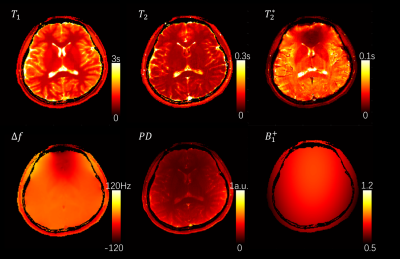 |
16 | Simultaneous T1 T2 T2* quantification using 2D EPI-MRF by shuffled sampling and compressed time-resolved reconstruction with B0 B1+ correction
Di Cui1, Xiaoxi Liu1, Peder E.Z. Larson1, and Duan Xu1
1University of California, San Francisco, San Francisco, CA, United States Keywords: MR Fingerprinting/Synthetic MR, MR Fingerprinting A 2D EPI based MRF acquisition and reconstruction method was developed in this study. A shuffled acquisition order and pseudo-randomized sampling pattern was designed for 2D k-space and compressed time-resolved reconstruction was utilized for faster reconstruction. T1 T2 T2* were simultaneously quantified, B0, B1+ and proton density maps are generated. |
|
2191.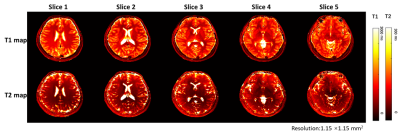 |
17 | Correction of B0 Eddy Current Effects in Magnetic Resonance Fingerprinting at 5.0T Whole Body Scanner
Yifan Guo1, Lixian Zou2, Congcong Liu2, Fanshi Li2, Yanjie Zhu2, Xin Liu2, Hairong Zheng2, Dong Liang2, and Haifeng Wang2
1Research Center for Medical AI, Shenzhen Institutes of Advanced Technology, Chinese Academy of Sciences, Shenzhen, China, 2Paul C. Lauterbur Research Center for Biomedical Imaging, Shenzhen Institutes of Advanced Technology, Chinese Academy of Sciences, Shenzhen, China Keywords: MR Fingerprinting/Synthetic MR, MR Fingerprinting Spiral-based MR fingerprinting (MRF) is an efficient T1 and T2 quantification technique for simultaneous measurement of tissue properties. Affected by the artifacts caused by the B0 eddy currents effects at 5T, a system response eddy current correction strategy is proposed to mitigate the blurring and artifacts of the MRF Spiral. The results of in vivo experiments on the head and abdomen showed that our approach to correct the artifacts caused by the B0 eddy currents was effective. |
|
2192.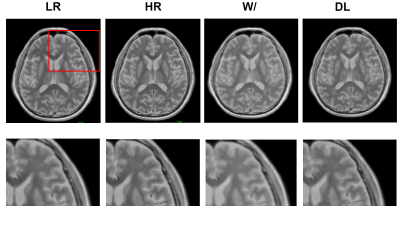 |
18 | Super-resolution GAN network for fast quantification of proton density mapping from highly accelerated synthetic magnetic resonance imaging
Yawen Liu1, Pengling Ren2, Hongxia Yin3, Yi Zhu4, Rong Wei5, Tingting Zhang2, Zuofeng Zheng6, and Zhenchang Wang1,2
1School of Biological Science and Medical Engineering, Beihang University, Beijing, China, 2Department of Radiology, Beijing Friendship Hospital, Capital Medical University, Beijing, China, 3Department of Medical Engineering, Beijing Friendship Hospital, Capital Medical University, Beijing, China, 4Philips Healthcare, Beijing, China, 5Peking university Academy for Advanced Interdisciplinary Studies, Beijing, China, 6Beijing ChuiYangLiu Hospital, Beijing, China Keywords: MR Fingerprinting/Synthetic MR, Image Reconstruction Quantitative magnetic resonance imaging (qMRI) can reflect the inherent characteristics of human tissue of relaxation time and proton density, and has important value for clinical diagnostic. However, long scan times limit the use of qMRI. We propose a method to optimize fast qMRI using a super-resolution generative adversarial network, thereby reducing scan time and obtaining accurate quantitative values. The results showed that this method was able to improve the image quality of qMRI, and the quantitative values were not significantly different from those obtained in conventional acquisitions. |
|
2193.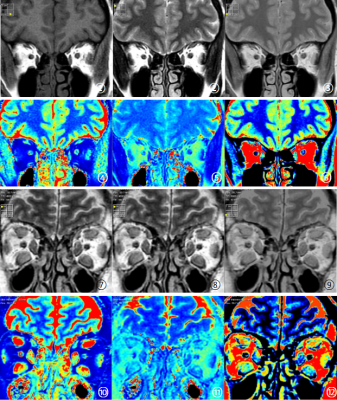 |
19 | The diagnostic value of synthetic MRI in predicting the activity of Graves ophthalmopathy
Luxi Yang1, Wenhua Wang1, Yunwen Chen1, Miaoqi Zhang2, Lisha Nie 2, Xiao Zhang1, and Zhihua Pan1
1416 Hospital of Nuclear Industry, Chengdu, China, 2GE Healthcare, MR Research, Beijing, China Keywords: Quantitative Imaging, Head & Neck/ENT In this study, we aim to investigate the performance of quantitative measurements from synthetic MRI in predicting the disease activity of Graves’ ophthalmopathy (GO). 40 patients with different Clinical Activity Scores are investigated. We found a trend that the muscles’ T1, T2 and PD values increased with increasing CAS level, spatially for T2 values. Furthermore, fact that T2 escalation in ‘inactive’ CAS groups compared with healthy controls, indicate CAS staging may underestimate disease activity. We conclude that synthetic MRI have potential to predict clinical activity of GO, and T2 value has the highest diagnostic efficiency. |
|
2194.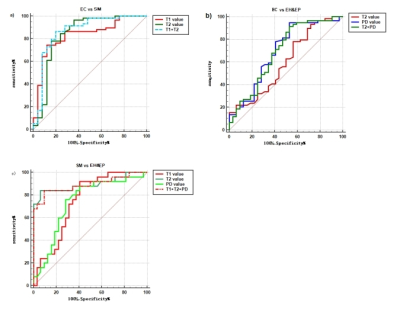 |
20 | Synthetic MRI derived Quantitative Maps in Diagnosis of Endometrial Carcinoma
Hailei Gu1, Weiqiang Dou2, and Wenwei Tang1
1Women's Hospital of Nanjing Medical University, Nanjing Maternity and Child Health Care Hospital, Nanjing, China, 2GE Healthcare, MR Research China, Beijing, China Keywords: Data Analysis, Cancer This study aimed to investigate whether synthetic-MRI can diagnose endometrial carcinoma (EC). 116 patients were recruited, including submucous myomas(SM),endometrial hyperplasia and endometrial polyps(EH&EP) and EC. Synthetic MRI derived T1, T2 and proton density(PD) mapping were obtained for each patient. Significantly different T1 and T2 were shown between EC and SM, and the optimal diagnostic efficacy was for T1+T2 with AUC of 0.865 . T2 and PD were also different between EC and EH&EP. The corresponding optimal diagnostic efficacy was for T2+PD with AUC of 0.690. With these findings, synthetic-MRI may thus be effective in differentiating EC from other intrauterine diseases. |
|
The International Society for Magnetic Resonance in Medicine is accredited by the Accreditation Council for Continuing Medical Education to provide continuing medical education for physicians.